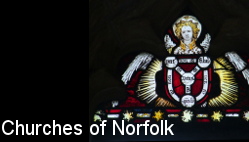
home I index I latest I glossary I introductions I e-mail I about this site
St Andrew, Frenze
| St
Andrew, Frenze We are a stone's throw from the Suffolk border, and Frenze church sits barely any distance at all from Diss railway station, but it is remote, across the fields hidden in a copse of trees. To reach it, you need to head out of Diss and journey almost a mile from the nearest road. From a country lane signposted somewhat unpromisingly to Diss Business Centre, you soon reach clear rolling country, and at a bend in the road a concrete track heads off to Frenze Hall. This heads down through the woods and then upwards until eventually it comes out into an empty farmyard, apparently abandoned, although the farm house is still occupied. In one corner of the yard, on a rise behind an old wooden fence, sits the church of St Andrew, Frenze. It is a curious looking structure. Effectively, it is just the small nave of a formerly longer 14th Century church, propped up but still leaning all over the place. The chancel was demolished in the early 19th Century. The red brick porch was probably under construction in the early 16th Century, for in 1521 one Margaret James gave a cow to the reparation of the porch. You step through it into a soft grey light falling on bare wood and old stone. Although the font and a few other features survive from medieval times, the overwhelming flavour of the inside is of the 17th Century, a silvery white family pew facing across to its partner pulpit, clearly by the same hand. The church is redundant and in the care of the Churches Conservation Trust, and perhaps because of this is charged more intensely with the past of this tiny parish than its present. And this would just be a beautiful, unspoiled hidden corner of Norfolk if it were not for one curious thing, for this church has no fewer than seven figure brasses, more than just about any other church in East Anglia, as well as other memorial inscriptions. An extraordinary find in such a place. They are
between eighteen and twenty-four inches tall. Mostly,
they are to the Blenerhaysett, or Blennerhassett, family
and their relatives, a most un-East Anglian name. In the
Paston letters, Sir John scoffs that Ralph Blenerhaysett
is a name to start a hare. The family came from
Cumbria, and they were the Lords of the Manor here in the
15th and 16th Centuries. Six of the figures are still in
situ on the floor. The vowess Joan Braham, who died 1519,
stands in her cloak and girdle. Jane Blenerhaysett, who
died in 1521, wears a kennel headdress, while her husband
John Blenerhaysett, who died in 1510, stands in armour
with his sword. John's father and Paston's correspondent
Ralph Blenerhaysett, who died in 1475, wears full mail.
Then there is a lovely shroud brass to Thomas Hobson. It
is undated but is in the style of a Norwich workshop of
about 1520. Pray for ye
sowle of your charite of Thomas Hobson to ye trynyte
reads his inscription. A mid-16th Century brass of Anne
Duke is also in a kennel headress, and the contemporary
brass figure of Thomas Playters has been reset on the
wall. Other inscriptions also survive Simon Knott, November 2022 |
|
|||||||||||||||||||||||||||||||||||||||||||||||||||||||
home I index I latest I introductions I e-mail I about
this site I glossary
Norwich I ruined churches I desktop backgrounds I round tower churches
links I small
print I www.simonknott.co.uk I www.suffolkchurches.co.uk